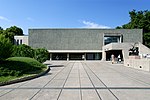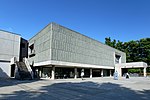National Museum of Nature and Science
1871 establishments in JapanArt Deco architecture in JapanBuildings and structures in TaitōMuseums established in 1871Museums in Tokyo ... and 5 more
National museums of JapanNatural history museums in JapanNeoclassical architecture in JapanScience museums in JapanUeno Park

The National Museum of Nature and Science (国立科学博物館, Kokuritsu Kagaku Hakubutsukan) is in the northeast corner of Ueno Park in Tokyo. The museum has exhibitions on pre-Meiji science in Japan. A life-size blue whale model and a steam locomotive are on display outside.
Excerpt from the Wikipedia article National Museum of Nature and Science (License: CC BY-SA 3.0, Authors, Images).National Museum of Nature and Science
Kanda-Hakusan Line, Taito
Geographical coordinates (GPS) Address External links Nearby Places Show on map
Geographical coordinates (GPS)
| Latitude | Longitude |
|---|---|
| N 35.715939 ° | E 139.776527 ° |
Address
国立科学博物館
Kanda-Hakusan Line
110-8718 Taito
Japan
Open on Google Maps











